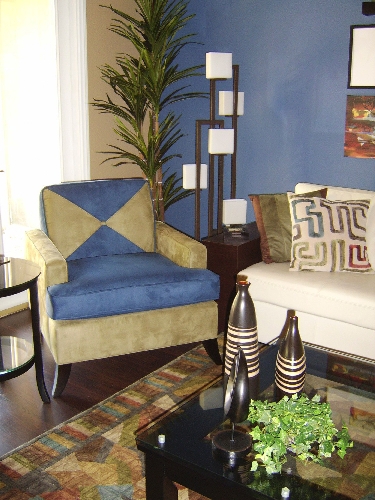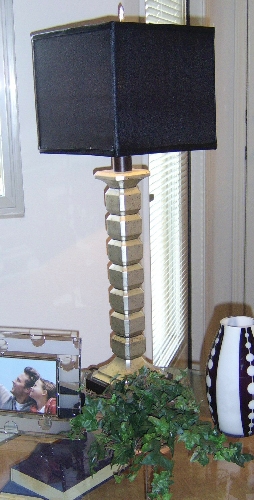Create lighting plan that meets needs, accents features
DEAR GAIL: For years we've only used the light from our ceiling fan in our family room and know it's not been enough. We're redecorating and want to do it right. What type of lighting do we need and how much? Thanks. -- Ann and Bill
DEAR ANN and BILL: You're right; light from a ceiling fan is not enough to properly light a room. Lighting is an area where I feel more is better -- as long as it's the right kind.
Just so you know, you're not alone in not having enough light. It's extremely rare that I find enough or proper type of light when I go into a home.
You've heard me say many times when decorating a room that paint is the least expensive, quickest and most dramatic decorating item to add. But without light, the room has no life. So let's get your room lit up with the three types of lighting sources you should have: general, task and accent.
General or ambient lighting is the base plan of lighting for every room as it spreads light throughout the space. That's where you want to start. This is the overall lighting that brings in a comfortable amount of light into a room and provides enough light to see and safely move around a room. Ceiling lighting from your fans or recessed cans is part of general lighting, but not all of it. You also need table and floor lamps, which are called portable lighting.
Table lamps are designed to mainly direct light downward and to the sides, and not really up. This is also true for floor lamps that have the small type of shades as your table lamps; they just provide light from higher up, giving you a wider spread of light. If you want upward light, which provides more ambience and background light, use a torchiere floor lamp.
If possible, look for table and floor lamps that accept three-way light bulbs. You can buy fluorescent three-way light bulbs, but if you like incandescent lighting, stock up. The phase-out of incandescent bulbs starts in 2012 with the 100 watt and will end in 2014 with the 40 watt. Actually, the last major U.S. factory making ordinary incandescent light bulbs closed in September of this year.
Now that you know your ceiling fan is not enough, I'd suggest adding three portable lights. When placing your lamps they should form a triangular pattern. This ensures that you have properly lit all the areas in a room. You want it so that when the lamps are turned on, without your ceiling lights, it creates a comfortable environment. Ceiling lights, unless on dimmer, can be too bright to have on all the time, which is why you want to add table and floor lamps.
Next is task lighting, which is directional light for a specific task. It can be considered part of your general lighting plan, but it also is selected and placed for a specific task, not just for ambient light.
Consider what else you do in your family room besides watching TV. If you like to read, you'll need a lamp that is tall enough so that the light shines down on your book -- about 30 inches tall. If it's too small and only projecting light on your table, it does you no good. Plus, make sure the wattage is high enough for you. I personally need at least 100 watts to read.
Before I forget, I also want to mention shade colors. If it's going to be a lamp for reading, a lighter-colored shade is better as it will provide more light. Also, a wider shade at the bottom will give a broader spread of light.
As in all design, form follows function. Once, I found a lamp that had a stainless steel shade. It would have looked great in my office, but sitting on my desk it didn't give me enough light to see anything, plus the shade got extremely hot. I loved the look but it wasn't functional at all. Instead I found one with a glass shade that gives me plenty of light.
With your general and task lighting covered, it's time to bring in accent lighting. Accent lighting directs attention to a space or object. You would use accent lighting to light an art niche, wall gallery, a sculpture or something of particular interest. Some examples of accent lights are track, spots, sconces and cans.
Table, floor and ceiling lights are not consider directional accent lighting. One of my exceptions though to this is small lamps in bookcases, if you have access to a plug.
If you don't have anything in particular to accent, I'm sure you have a floor plant or tree. Place an uplight can on the floor behind it. This floods the corner with light and a nice silhouette of the branches on the wall. You can pick one up at any home-improvement store for less than $15.
So before you go shopping, consider each activity that you do in your family room, where you need the light and how much light you need. It's no different then when you are doing a decorating plan for a room, you need to have a lighting plan. So take that list and light up your room.
Gail Mayhugh, owner of GMJ Interiors, is a professional interior designer and author of a book on the subject. Questions may be sent by e-mail to: gail@gmjinteriors.com. Or, mail to: 7380 S. Eastern Ave., No. 124-272, Las Vegas, NV 89123. Her Web address is: www.GMJinteriors.com.


















